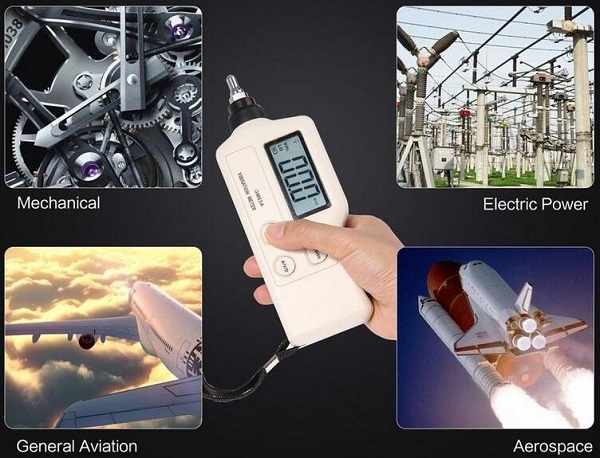A vibration meter is a handheld or portable instrument used to measure various parameters associated with mechanical vibrations. These devices are commonly used in predictive maintenance, reliability engineering, and industrial applications to assess the condition of machinery and structures. Vibration meters help identify and diagnose issues like imbalance, misalignment, bearing wear, and other mechanical problems that can lead to equipment failure.
Principles of Operation
The operating principle of a vibration meter is based on the kinematics and mechanics of vibration. When the equipment under test is in operation, the resulting vibrations are propagated to the measuring point, usually at the bearings of the equipment. The vibration meter measures these vibrations by means of sensors, and the resulting signals are converted into electrical signals. The vibration meter's computer converts these electrical signals into numerical values, which are parsed and analyzed by software to produce a measurement of the equipment's vibration level.
Main Components
- Sensor or Transducer: Vibration meters rely on sensors or transducers to convert mechanical vibrations into electrical signals. Common types of sensors include accelerometers, velocity transducers, and piezoelectric sensors. The choice of sensor depends on the specific application and the type of vibrations being measured.
- Signal Conditioning Circuitry: The electrical signals generated by the sensor may need amplification, filtering, and conditioning to ensure accurate and reliable measurements. This circuitry prepares the signal for further analysis and data processing.
- Display: Most vibration meters have a digital display that provides real-time readouts of vibration measurements, including velocity, acceleration, and displacement. This display allows users to quickly assess the condition of machinery or structures.

Key Functions
- Predictive Maintenance: Vibration meters are commonly used in predictive maintenance programs. By regularly monitoring the vibrations of rotating machinery, such as motors, pumps, fans, and turbines, maintenance personnel can detect early signs of equipment wear, misalignment, imbalance, and other issues. This helps prevent unexpected breakdowns and minimizes downtime.
- Condition Monitoring: Vibration meters are employed to continuously monitor the condition of critical equipment and infrastructure. This is crucial in industries where equipment failure can lead to safety hazards, production losses, or costly repairs.
- Fault Diagnosis: Vibration analysis can pinpoint specific faults in machinery. The data collected by vibration meters, along with detailed spectral analysis, can help identify problems like bearing wear, gear tooth damage, or unbalanced rotors.
- Bearing Health Assessment: Bearings are essential components in many machines. Vibration meters are used to assess the health of bearings by detecting irregularities in vibration patterns that may indicate bearing defects.
- Machine Balancing: In rotating machinery, imbalances can cause excessive vibrations. Vibration meters aid in the process of machine balancing, helping technicians identify and correct imbalance issues.
- Alignment of Machinery: Vibration meters are used to ensure that machinery components are properly aligned. Misalignment can lead to vibrations and premature wear on equipment.
- Structural Health Monitoring: In construction and civil engineering, vibration meters are used to monitor the structural health of buildings, bridges, and other infrastructure. This helps ensure safety and assess the effects of external forces like wind or seismic activity.
- Quality Control: In manufacturing, vibration meters can be used to ensure product quality by monitoring vibrations during the production process. This is particularly important in precision manufacturing and industries like automotive and aerospace.
- Real-time Monitoring: Some vibration meters offer real-time monitoring, which is valuable in applications where immediate action is required to address vibration-related issues.
- Trend Analysis: Vibration data can be recorded and analyzed over time to identify trends. This trend analysis is essential for proactive maintenance planning and identifying long-term changes in machinery performance.
Types of Vibration meter
Handheld vibration meter
Handheld vibration meter is a simple structure, that can measure the vibration in any direction, measuring speed dig =1000 ~ 2000 RPM, / time, the error is small.
Piezoelectric vibration meter
Piezoelectric vibration meter is characterized by high natural frequency, wide frequency range, small volume, lightweight, and little influence on the measured object, so it has been widely used in the measurement of vibration acceleration. The internal resistance of the piezoelectric vibration tester is high, and the cable connected with the amplifier is easy to introduce interference, so it is hoped that the cable should be as short as possible shielding should be considered, and the preamplifier should be placed near the sensor as much as possible. Most amplifiers used to amplify the electrical signals generated by piezoelectric sensors are now charge amplifiers.
Mechanical vibration meter
It is by inserting a spring (or several springs) into the housing and installing a mass block of mass m underneath the spring. This also constitutes the mechanical resonance system. Usually, mechanical resonant systems are damped.
Table frame vibration meter
Table frame vibration meter is fixed on the meter frame, the meter frame is fixed on the support isolated from the fan, and the measuring rod of the meter and the bearing box surface or other measuring parts can be measured. This kind of vibration meter does not need to make any other machine parts, simple structure, and can measure any direction of vibration. The disadvantage of the table frame vibrator is that the support is not easy to isolate from the vibration, and the accuracy is poor.
Vibration meters play a crucial role in ensuring the reliability, safety, and efficiency of various mechanical systems and structures. They are essential tools for professionals in maintenance, engineering, and quality control across multiple industries. sisco shop offers high quality, reasonably priced vibration meters for sale online, such as handheld pen vibration meters, portable digital vibration meters, and other vibrometers, if you are interested in it, welcome to click and buy.

